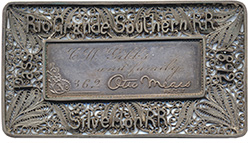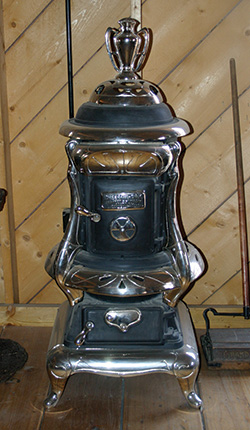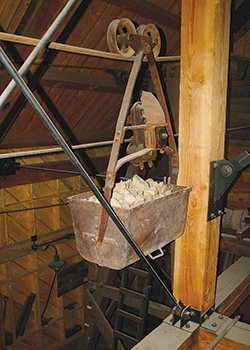October 24, 2023
Silverton’s Mining Heritage Museum
MINING HERITAGE MUSEUM
Story by Scott Fetchehier
Photography by Kathryn Retzler
One of Silverton’s “must see” attractions is the San Juan County Historical Society’s Heritage Center consisting of the old San Juan County Jail, the new Mining Heritage Museum, and the Allen Nossaman Memorial Archives that houses the extensive paper and photographic collection of the Society’s.

1892 Rio Grande Southern Railroad silver filagree railroad pass signed by Otto Mears.
Courtesy San Juan Historical Society
The Jail, built in 1908, still has the cold steel cells upstairs so one can still feel what it was like to be in the “hoosegow” in the early 1900s. If the kids get too unruly you can just leave them behind bars. The jailer’s rooms are still visible on the ground floor and contain displays on life in Silverton, railroad memorabilia, Otto Mears passes, and gun collections. In the basement is a fine collection of local mineral specimens from San Juan mines, uranium minerals, and a collection of minerals from around the world.
The Mining Heritage Museum will eventually house the extensive mining artifacts the Historical Society has been collecting for decades. The frontispiece of the museum is the impressive Caledonian Boardinghouse, rescued from its state of decay in Minnie Gulch and re-erected in Silverton. [Related story, page14.] The corners of the building were put together using double dove-tail joints, which reveal the incredible workmanship of the carpenters who built it. The boardinghouse is home for the Tommy Savich collection, printing presses, bank and post office displays, and it will eventually contain many artifacts pertaining to life in the San Juan boarding houses.

Ornate wood stove.

SJCHS mining museum, ore bucket on tram to old headworks.
The main museum consists of three floors of displays: mining in the basement, mining and transportation on the ground floor, and Silverton displays on the mezzanine level. A mine display is being built on all three floors—a haulage level, slusher scram level, and stope so that visitors can see a mine in three dimensions. There will be various pieces of mine equipment on each level—ore cars, motors, and muckers in the basement, a slusher setup on the ground floor, and drills and tools in the stope above.
The basement is connected to the old jail by a tunnel and consists of various displays on mining, drilling, explosives, hard hats, mine lights, and mine rescue, with other displays on geology, mine surveying, assaying, and exploration. Also in the basement are an authentic mine blacksmith shop and a machine “doctors” shop where various drills would be repaired.
On the ground floor is a tram tower from Arrastra Gulch that was re-erected in the museum along with various tram buckets and displays. There are several wagons displayed on this floor including the heavy duty ore wagon and an Omnibus used in Silverton to transport train riders from the depot to the town. Other displays include a fine collection of carpenter’s
tools.
The upper floor gives visitors a great view of the tram tower and mining displays along with the massive timbers used in the construction of the main museum building. The floor hosts pianos and brass band instruments, and a collection of antique stoves.
Walking outside one can see several pieces of mine equipment donated from the Sunnyside mine including a 25-ton diesel motor used to tram ore on main level and a ten-ton ore car.
So step back in time for an hour or two, and enjoy the history of Silverton and San Juan County.
It’s a stop you won’t want to miss.
